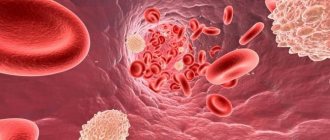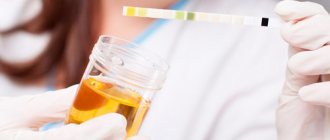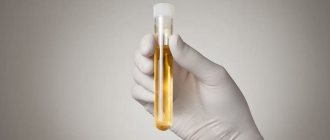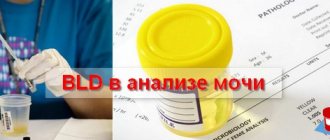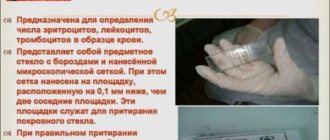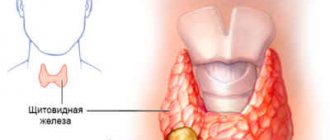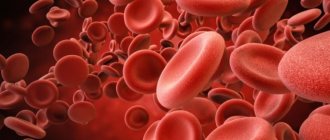Uro in urine analysis. Content standards. Methods for normalizing indicators
Urobilinogen is a pigment that is produced by the gallbladder and is removed from the body along with urine.
The chemical formula of urobilinogen is C33H44N4O6. Urobilinogen received its name from the medical terms uron - urine, bilis - bile and genesis - origin.
In fact, urobilinogen is the result of the breakdown of red blood cells. Red blood cells synthesize the protein compound hemoglobin; as a result of metabolic processes, hemoglobin is converted into bilirubin, which, in turn, into urobilinogen.
After the expiration of their service life, red blood cells are removed from the body with the help of the excretory system. Bilirubin, formed by hemoglobin, is processed in liver tissue, synthesizing direct bilirubin. Direct bilirubin is broken down by intestinal bacteria into many compounds, which are partially excreted from the body in bile and partially in urine.
Urobilinogen in urine
Urobilin, which is excreted from the body along with urine, is oxidized upon contact with the atmosphere. As a result of a chemical reaction, the substance urobilin appears in the urine, due to which the urine becomes duller after a certain period of time.
The presence of a certain amount of urobilinogen in a urine test is considered not only normal, but also mandatory for the patient’s healthy condition, since it is a common product of metabolism. However, an imbalance in its concentration may indicate the development of various dangerous diseases of the liver and other related internal organs of a person.
Urobilinogen in urine - what does it mean, reasons for deviations from the norm
Urobilinogen (uro) is a pigment, a product of bilirubin, which is found in urine in trace amounts. It is formed inside the intestines under the influence of bacteria. Most of the pigment is excreted in the feces, a small part enters the bloodstream, is filtered through the kidneys and enters the urine. Increased urobilinogen in the urine is an indicator of diseases of the gastrointestinal tract and urinary system. In order to find out what urobilinogen in the urine means, you need to consult a therapist. The obstetrician-gynecologist may send the pregnant woman for a consultation with a gastroenterologist.
Urobilinogen in urine - what does it mean?
Bilirubin is a substance secreted by hepatocytes. It undergoes transformation and oxidation, after which it becomes common urobilinogen. It is divided into:
- Urobilinogen. Occurs under the influence of bile inside the gallbladder. Together with it, it passes into the intestines. Further into the intravascular fluid, from the blood it passes to the liver. One part again enters the gallbladder, the other part of urobilinogen, which does not enter the bladder, passes to the kidneys. There it passes through the filtration structures and moves into the urine.
- Stercobilinogen, which turns into stercobilin inside the intestine. One part enters the blood, the other is excreted in the feces.
The function of the pigment is to color urine yellow. It should be light. If your urine turns dark, you should take a general urine test and consult a doctor. Its color can be affected by nutrition and the use of medications.
Important! If even a small level of bilirubin appears in the urine, this means the presence of pathology. Traces of urobilinogen are normal.
If urine sits in daylight for a long time, reactions inside it accelerate. Bilirubin will turn into urobilinogen. The urine test will not be accurate; the laboratory technician will not find the abnormal appearance of bilirubin.
To determine the amount of urobilinogen in urine, a general urine test is performed or special test strips are used. By urinating on them, a person will immediately know the amount of pigment. To determine the pigment using a general urine test, it takes more time and you need to come to the laboratory, but a urine test will reveal other indicators that will help in diagnosing the disease. Test strips are effective if pathology is detected and it is necessary to constantly monitor the amount of pigment.
Normal level of urobilinogen in urine
If the urine contains traces of uro, this is considered normal in healthy people. Some of it enters through the filtration barrier of the kidneys.
The level of urobilinogen in urine should not exceed 10 mg/l (this is 34 µmol). This number is a trace of the presence of pigment.
If urobilinogen in the urine increases (urobilinuria), this is indicated by crosses on the urine test form. This is an important indicator of the presence of a disorder in the body.
| Index | Meaning |
| + | weakly positive increase in urobilinogen in urine |
| ++ | positive increase in urobilinogen in urine |
| +++ | sharply increased amount of urobilinogen in the urine |
The norm of urobilinogen in urine in children
In children, the level of urobilinogen in urine (uro) depends on age. It increases for the same reasons as in adults. After birth, the baby’s intestines are sterile and not colonized by microorganisms that cause the conversion of bilirubin. The indicator appears only with physiological jaundice of newborns.
Normal uro indicators in children, depending on age:
| Child's age | Normal value |
| children under 1 month | up to 10 mg/l |
| children from 1 month to 1 year | No |
| children from one year old | 5-10 mg/l |
Urobilinogen levels in urine in pregnant women
During pregnancy, almost all indicators of blood, urine, and feces change. This is necessary to maintain all systems that contribute to gestation.
The level of urobilinogen in urine in pregnant women does not change or increases slightly. A sharp change in the number of uro indicates gastrointestinal disease, hemolysis (when red blood cells are massively destroyed), toxicosis.
Attention! If a woman has a change in the color of her urine, she should immediately consult a doctor and take a general urine test.
Pregnant women often do not follow a diet, consume a lot of salty foods, and dehydration occurs due to insufficient water intake. Then uro increases not because of the disease, but because of a decrease in body fluid. The urine also becomes dark.
Reasons for increased urobilinogen in urine
Uro in urine is not always increased in diseases. A physiological increase is observed in the first days of a child’s life (newborn jaundice), as a result of a decrease in the amount of urination, with insufficient water intake into the body, when the amount of pigment does not change, but the concentration becomes greater due to a decrease in fluid. Taking medications that cause changes in the water-salt balance causes an increase in the concentration of uro.
Urobilinogen in urine is increased in the presence of the following diseases:
- Liver dysfunction. Infectious damage to the organ (hepatitis) is accompanied by pain in the right hypochondrium and jaundice of the skin. The disease is curable. Cirrhosis (replacement of liver parenchyma with connective tissue) occurs with the same symptoms, but can only be treated with organ transplantation. Both diseases are accompanied by a sharp increase in uro in urine analysis.
- Poisoning accompanied by intoxication of the body. Accompanied by dyspeptic disorders (nausea, vomiting, diarrhea), increased body temperature. Urobilinogen increases if toxic substances reach the liver.
- Diseases that cause damage to the spleen. The organ performs the functions of metabolism and hematopoiesis. Since metabolic products pass through the liver and it is the site of disposal of blood cells, disorders of the spleen affect its functioning, causing an increase in pigment.
- Intestinal diseases that cause inflammation (enterocolitis). Dyspeptic disorders, bloating, and changes in intestinal digestion appear.
- Transfusion of the wrong blood type.
- The appearance of foreign elements inside the body (prostheses, valves).
With these diseases, the clarity of the urine changes (becomes darker), so the patient may suspect an exacerbation of the disease. Urobilinogen in the urine of a child increases for the same reasons as in adult women and men.
Important! For abbreviation, the study form uses the short name urobilinogen. For some laboratories - uro, for others - ubg in urine analysis.
Reasons for the decrease in urobilinogen in urine
The physiological reason for a decrease in ubg levels is an increase in body fluid. At the same time, the amount of the indicator does not change; its concentration decreases per 1 liter of liquid. The following diseases are characteristic of a decrease in the pigment of a patient’s urine:
- subhepatic jaundice, blockage of the bile ducts (uro decreases, bilirubin concentration increases);
- glomerulonephritis also causes a decrease in urobilinogen;
- impaired filtration capacity of the kidneys, the indicator decreases or is absent altogether;
- tumor diseases affecting the functions of the kidneys and liver.
What to do if urobilinogen in urine deviates from the norm
When receiving an analysis result with a deviation of urobilinogen from the norm (increase, decrease), they are retested for correct decoding. The result is distorted when urine is left in the sun for a long time or biomaterial is given inside a non-sterile container. Therefore, in the absence of pathological causes, treatment is not carried out.
If a repeat urine test shows the same results, you should consult a doctor to find out what urobilinogen is and to receive further treatment. Self-therapy cannot be carried out; an increase in uro formation may be an indicator of a serious illness. If the test result is too high, the doctor will prescribe instrumental diagnostics.
Doctors prescribe medication for changes in urobilinogen in the urine, folk remedies, and diet.
- Diet. Prescribed for detection of certain diseases of the gastrointestinal tract and liver (enterocolitis, hepatitis, cirrhosis). Alcohol, fried, spicy, smoked, salty foods are excluded. Baking is cancelled. Reduce the number of eggs per week. It is necessary to drink more water to thin the blood, reducing the concentration of this pigment per 1 liter of body fluid. Recommended foods: lean meat (turkey, chicken), dairy products, green vegetables, fruits.
- Medicines for the liver. Hepatoprotectors are prescribed for inflammation of the organ to protect hepatocytes from the effects of toxic substances. Antiviral drugs are used if the disease is viral in nature (hepatitis A). Droppers with minerals, vitamins, and saline are prescribed. They remove toxic substances from the body, correct the water-salt balance, and help improve the general condition of the body. Since the body is weakened by the disease and is at risk of secondary viruses and infections, immunomodulators are prescribed.
- Choleretic agents. Since uro is formed under the influence of bile, a decrease in its concentration leads to a decrease in pigmentation. To stimulate bile, choleretic drugs (Hofitol) are prescribed.
- In case of poisoning of the body, sorbents (Smecta, Polysorb), antiseptics (Enterofuril), agents that replenish the loss of body fluid (Regidron), and broad-spectrum antibiotics are prescribed.
- To treat enterocolitis, broad-spectrum antibacterial drugs, agents that support intestinal microflora (Normobact), enzyme preparations (Creon) to improve digestive function, and drugs that improve intestinal motility (Loperamide) are used.
If you consult a doctor in a timely manner when symptoms of malaise and clinical signs of the disease appear, the prognosis for the disease is positive.
Self-medication is excluded; you should strictly adhere to the doctor’s instructions for treatment.
To prevent an increase in urine urobilinogen and improve health, drink water (at least 2 liters per day), eat a healthy diet, apply hardening (swimming with cool water, walking barefoot at home, visiting the pool), and lead a healthy lifestyle.
Researcher at the Laboratory for the Prevention of Reproductive Health Disorders of Workers at the Research Institute of Occupational Medicine named after. N.F. Izmerova.
Elevated urobilinogen in urine analysis
There are two main reasons for high levels of urobilinogen in urine:
- Excessive accumulation of red blood cells in the body;
- Liver dysfunction. In this state, liver cells do not have time to cope with their direct responsibility - recycling decay products:
An increase in urobilinogen in urine is observed in the following diseases:
- Hemolytic anemia is a disease characterized by a decrease in hemoglobin levels due to increased decomposition of red blood cells and, as a consequence, the synthesis of an increased amount of urobilinogen.
- Severe injuries leading to extensive bruising. In this case, the released blood accumulates outside the vessels.
- Diseases that damage the liver. Such diseases prevent liver cells from utilizing urobilinogen, so it enters the blood and is removed after renal filtration along with urine. What diseases exactly?
- Viral hepatitis is a dangerous disease caused by the introduction of an infection into the body. Hepatitis destroys the immune system and liver tissue.
- Toxic hepatitis is a liver disease caused by all types of poisoning: alcohol, food (for example, poisonous mushrooms), chemical, drug overdose and others.
- Liver cirrhosis is a serious disease that destroys liver cells and disrupts intestinal function.
- Oncological.
In some cases, an increase in urobilinogen levels is not a symptom of liver dysfunction, but is caused by an unbalanced diet and non-compliance with the drinking regime.
Can URO be increased in urine during a cold?
Can URO be increased in urine during a cold?
Answered by Alexander Konev, therapist
Increased levels of urea are observed during febrile conditions, the use of salicylates, in the postoperative period and in a number of other conditions. If the cold was severe and accompanied by a prolonged increase in temperature, an increase in URO is possible.
Related questions:
- Lump on the neck - what could it be?
- Lump on the hand: what could it be?
- Nipple discharge: what could be causing it?
- What can cause severe chest pain?
- Red spot on the body that doesn’t itch: what could it be?
- All questions
- Allergology
- Andrology
- Pregnancy
- Venereology
- Gastroenterology
- Hematology
- Gynecology
- Dermatology
- Diagnostics
- Infectious diseases
- Cardiology
- Cosmetology
- Medicines
- Neurology
- Neurosurgery
- Emergency conditions
- Nephrology
- general surgery
- Oncology
- Orthopedics and traumatology
- Ophthalmology
- Parasitology
- Pediatrics
- Nutrition
- Psychiatry
- Psychology
- Pulmonology
- Radiology
- Rheumatology
- Dentistry
- Therapy
- Urology
- Phytotherapy
- Phlebology
- Surgery
- Endocrinology
OkayDoc © 2021 Information is provided for informational purposes only. Do not self-medicate. At the first sign of disease, consult a doctor. There are contraindications, a doctor's consultation is required. The site may contain content prohibited for viewing by persons under 18 years of age.
Unauthorized use of materials posted on the site is prohibited by copyright law. Using materials reference to the site is obligatory. Cookie Policy Personal Data Processing Policy
XThis website uses cookies and similar technologies to improve your experience. To learn more about the use of cookies on this website, please read the Cookies and Similar Technologies Policy. By using this website, you agree that we store and use cookies and similar technologies on your device.
Reduced urobilinogen in urine analysis
There are several reasons for the decrease in urobilinogen in the urine:
- Changes in the concentration of microorganisms in the intestine. Often this situation occurs after completing a course of antibiotic therapy.
- Jaundice. Cholestasis prevents the transport of bile to the colon. Obstacles include cysts, tumors, and stones. As a result, bilirubin does not penetrate the intestines, and, therefore, urobilinogen is not synthesized.
- Enzyme deficiency. Glucuronyl transferase is a substance that allows the synthesis of direct bilirubin.
Norm of urobilinogen content
Recently, the most technologically advanced methods have been used to study biomaterial: urine analysis is carried out using special urine analyzers. Analyzers detect UBG - the level of urobilinogen. The presence of traces of urobilinogen in the analysis is normal. However, for breastfed babies, the absence of urobilinogen in the urine is considered the norm, since in the first months breast milk protects the baby’s body from foreign microorganisms that are required for the synthesis of urobilinogen.
The norm for urobilinogen content for a healthy person is five to ten milligrams per liter of liquid.
How does urobilinogen form?
Normally, the lifespan of red blood cells is about 120 days (if during this time there was no pathological effect on them - injury, exposure to hemolytic poisons, etc.). The “obsolete” red blood cell is sent to the spleen, where it is destroyed in the cells of the reticular formation.
The hemoglobin molecule contained in the red blood cell breaks down into globin (protein) and heme (ferrous ion). Next, as a result of several biochemical reactions, the heme molecule is converted to biliverdin, an inactive form of bilirubin, which then undergoes activation to form the final molecule of the named bile enzyme.
Bilirubin can exist in 2 forms - conjugated and unconjugated (depending on whether glucuronic acid molecules are attached to it). Unconjugated bilirubin is a fairly toxic substance that can cause significant damage to body cells. It is poorly soluble in liquids, but passes well through cell membranes, which determines its toxic effect.
Conjugated bilirubin is of greater interest, since it is the precursor of urobilin. It is formed in the liver, after which it is released into the intestinal lumen with bile, where the formation of two bilirubin derivatives - urobilinogen and stercobilin.
Stercobilin is the end product of bilirubin oxidation and is formed in the colon. Urobilinogen is absorbed in the small intestine and enters the blood plasma. It is due to it that the skin acquires a yellow color in organic liver diseases. It is carried through the bloodstream to the kidneys, where it is filtered and released into the urine.
As mentioned above, in order to determine urobilin in urine, there must be disturbances in the functioning of the liver and intestines.
Poor urobilinogen levels. What to do?
After receiving not very good results for urobilinogen, the main thing is to eliminate the cause of its increase or decrease. You should normalize your diet, refrain from eating fatty foods, alcoholic substances, and smoking. It is also very important to monitor the fluid balance in the body. It is recommended that you discuss your diet and diet with your doctor.
Another important aspect is the correct daily routine. In order not to overload the liver, it is recommended to sleep from 21 to 3 a.m. at a minimum, because it is during this period of time that the liver works most productively and it is important to create the most comfortable conditions for it.
Regarding the dietary regime, you can be a little more specific. Experts advise consuming mainly dairy and plant foods; such a diet will have a beneficial effect on the performance of the liver and other internal organs. In addition, you can improve intestinal function by drinking tinctures of bitter herbs. The best herbs are elecampane, wormwood, immortelle, milk thistle and tansy. To prepare the infusion, boil a tablespoon of the herb in half a liter of clean water, then let it steep for several hours. Warm before use.
Similar articles:
- The UBG indicator in a general urine test: what it is, norm and explanation The abbreviation UBG in a urine test is an indicator of the concentration of urobilinogen. Presence…
- BLD in a urine test - interpretation of the analysis, norm and deviation BLD in a urine test - this is most often not very...
- Urinalysis according to Addis Kakovsky. Normal content of elements This article shows the positive and negative aspects of urine analysis...
- Urobilin in urine. Deviations from the norm - what to do Why is it important to monitor the level of urobilinoids in the urine? What is their norm...
Urine test for colds: Is it possible to take it, Interpretation of results
In the life of every person, a situation is possible when there is a referral for a urine test and urine collection needs to be done in the coming days, but a cold has arisen. At the same time, the prescribed diagnosis was not associated with ARVI pathology.
Is it possible to take
Is it possible to take a urine test if you have a cold? If the purpose of examining a patient is precisely to establish the fact of the development of inflammation in the body, then what is revealed as a result of urine tests?
For colds and acute respiratory viral infections, a general urinalysis (UCA) makes it possible to determine the severity of the infectious process, since severe inflammation and complications greatly change the indicators.
When collecting urine for analysis, all rules must be followed. If the genitals are not washed enough, an excess of leukocytes will be detected in the test sample. They directly indicate an inflammatory process in the body. The permeability and filtration of the kidneys changes, leukocytes penetrate into the urine.
Interpretation of results
Interpretation of the analysis results with confirmation of a cold is carried out according to several indicators:
- transparency (in case of influenza, cloudy due to the many epithelial cells and leukocytes in the sample);
- density (the indicator shifts with kidney inflammation or diabetes, but does not change with ARVI and influenza);
- protein (for a cold, up to 1 g is determined, which indicates a fever and an infectious process);
- blood cells (an increase in the number of leukocytes and erythrocytes during microscopy of dry urine residue indicates bacterial and purulent complications, tumors in the body).
Mild forms of colds change urine parameters slightly.
